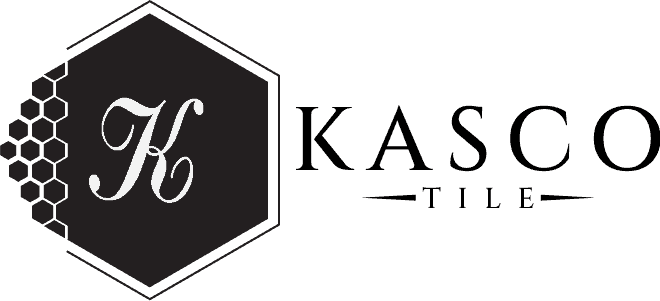The Growing Trend of Bathtub Installations in Milford, NJ
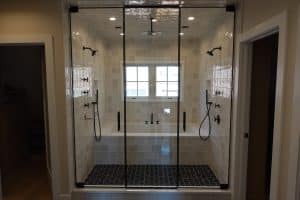
In recent years, bathtubs have been making a remarkable comeback in bathroom renovation trends, especially in Milford, NJ. Once considered a luxury, bathtubs are now being recognized for their aesthetic appeal, practicality, and potential to increase property value. This shift has encouraged many homeowners to explore the benefits of incorporating a bathtub into their master bathroom.
For homeowners considering a renovation, adding a bathtub can be a pivotal decision. It’s not only about creating a space for relaxation and luxury but also about making a long-term investment that can yield significant returns, both in terms of daily satisfaction and home value. Let’s delve into why you should consider this upgrade, starting with the aesthetic benefits a new bathtub can bring to your master bathroom.
It’s important to first explore the aesthetic benefits of a bathtub remodel. You want your bathtub to add to your master bathroom, so you should aim for a cohesive aesthetic. Let’s look at how you can enhance your bathroom’s visual appeal through different styles and designs of bathtubs on the market.
—
Aesthetic Benefits of Adding a Bathtub
When you add a bathtub to your master bathroom, you significantly enhance its visual appeal. A well-chosen bathtub can serve as a stunning centerpiece, transforming an ordinary bathroom into a luxurious, spa-like retreat. The choice of style and design is crucial to achieving the desired aesthetic.
Consider freestanding tubs, which have gained popularity for their elegance and versatility. They can be placed anywhere in the bathroom, offering a variety of design possibilities. Alternatively, clawfoot tubs provide a vintage charm, perfect for those aiming for a traditional look.
Other options include modern, sleek tubs with clean lines that blend seamlessly into contemporary bathroom designs. By choosing the right style and design, you can ensure that your bathtub complements the rest of your bathroom decor and elevates the overall visual appeal.
Adding a bathtub to your bathroom goes beyond enhancing your space – it can turn this area into your oasis. So, let’s take a look at the plethora of benefits adding a bathtub can have on your master bathroom!
—
Practical Benefits of Bathtub Installations
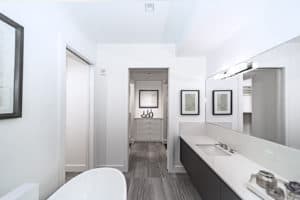
A bathtub is more than just a visual enhancement; it offers numerous practical benefits that can improve your daily life. For instance, bathtubs are excellent for relaxation and stress relief. Imagine unwinding in a warm bath after a long day, easing stress with the help of calming water and bath salts. This can turn your bathroom into a personal oasis where you can recharge.
Furthermore, bathtubs are highly beneficial for families with small children. Bath time becomes a manageable and enjoyable experience for both parents and kids. It provides a safe and comfortable space for bathing young children, which can be less stressful than using a shower.
For those who enjoy at-home spa treatments, a bathtub can be the perfect addition. It supports various practices such as aromatherapy and soak therapies, enhancing your overall well-being right within your home.
You are now well aware that adding a bathtub can elevate your master bedroom, but did you know it can also increase your home’s value? We’ll delve into how a bathtub can impact your property value.
—
Impact on Property Value
A well-designed bathtub can indeed elevate the value of your home. In real estate markets, bathroom renovations often yield some of the highest returns on investment. Potential buyers are increasingly looking for modern, luxurious bathrooms with features like bathtubs, which can set your property apart in a competitive market.
Statistics show that bathroom renovations, including the addition of a bathtub, can offer a substantial return on investment. This is particularly true in places like Milford, NJ, where homeowners value high-quality upgrades. A beautifully designed master bathroom with a contemporary bathtub can significantly boost your home’s appeal, resulting in a higher appraisal and a quicker sale.
You may be worried about how a bathtub will impact the space of your master bathroom. However, we have some tips and tricks that will help optimize your space.
—
Space and Layout Considerations
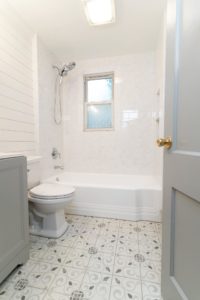
Now that we’ve discussed the value and allure a bathtub can bring to your master bathroom, it’s crucial to consider the practical aspects of installation, specifically space and layout. One common concern is whether the current layout of your bathroom can accommodate a bathtub. This step is essential to ensure that the addition will enhance rather than obstruct the overall functionality and flow of your space.
Start by evaluating the size and dimensions of your bathroom. Measure the available space meticulously and consider different layout options. For smaller bathrooms, corner tubs or compact alcove tubs might be ideal as they optimize space efficiently. For more spacious bathrooms, freestanding or built-in tubs can serve as stunning focal points and offer a sense of luxury.
When planning the layout, think about accessibility and comfort. Ensure there’s adequate space around the tub for easy entry and exit, and consider the placement of other elements such as sinks, toilets, and storage. A well-planned layout not only improves practicality but also contributes to the overall aesthetic and user experience.
We may have previously talked about the different styles of tubs, but now we’ll delve further into different tub types and what they can offer your bathroom space. Picking the right bathtub for you is tricky, but here you’ll learn everything you need to know about the different types on the market.
—
Types of Bathtubs to Consider
Choosing the right type of bathtub is a critical step in the renovation process. The market offers a variety of tubs, each catering to different needs and design preferences.
Freestanding Tubs: These tubs are versatile and can be placed almost anywhere in the bathroom, offering a striking aesthetic appeal. They come in various shapes, including oval, rectangular, and slipper designs, catering to both modern and traditional tastes.
Alcove Tubs: Ideal for smaller spaces, alcove tubs are installed against three walls, with one finished side exposed. They often include a showerhead, providing the convenience of a combined shower and bath area, making them a practical choice for those with limited space.
Corner Tubs: These tubs maximize space by fitting neatly into the corner of the bathroom. They are typically larger, providing ample space for a relaxing soak and are perfect for bathrooms with an irregular layout.
Drop-In Tubs: Designed to drop into a pre-built deck or enclosure, these tubs offer a seamless, integrated look. They require sufficient space for the surrounding deck but can be customized extensively to match your bathroom’s design.
Clawfoot Tubs: For a touch of vintage charm, clawfoot tubs stand elevated on four feet and are reminiscent of classic Victorian designs. They add a sense of elegance and nostalgia to any bathroom.
Each type offers unique benefits, and understanding these can help you make an informed decision that aligns with both your aesthetic preferences and functional needs.
Once you’ve determined the type of tub for your master bathroom, it’s also important to consider the material. The material of your bathtub impacts both its durability and aesthetic appeal. Here, we’ll explore the pros and cons of different materials to help you make the best choice.
—
Best Materials for Your Bathtub
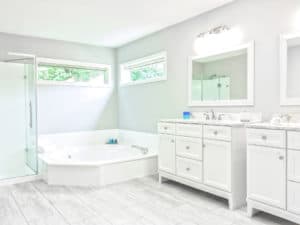
The material of your bathtub plays a vital role in its functionality, maintenance needs, and overall look. Here’s a closer look at the most popular materials and their respective pros and cons:
Acrylic: Acrylic bathtubs are lightweight, affordable, and available in numerous shapes and sizes. They retain heat well, ensuring a warm bath experience. However, they can be prone to scratching and require gentle cleaning.
Cast Iron: Known for their durability, cast iron tubs are coated with enamel to prevent rust and staining. They have excellent heat retention and a classic look, though they are very heavy and may require structural reinforcement of the floor.
Fiberglass: Another budget-friendly option, fiberglass tubs are lighter and easier to install. They’re less durable than other materials and can suffer from scratches, but they’re easy to repair and maintain.
Porcelain-on-Steel: These tubs are constructed with a thin steel shell coated in porcelain enamel. They are durable and affordable but can chip and rust if the porcelain layer is damaged.
Stone Resin: Offering a high-end, luxury feel, stone resin tubs resemble natural stone and provide excellent heat retention. They are durable and visually striking but come at a higher price point.
Copper: For a unique, rustic aesthetic, copper tubs are a stunning choice. They are naturally antibacterial and develop a beautiful patina over time. Their bespoke nature and high price make them less common.
Selecting the right material depends on your budget, maintenance preferences, and the overall style of your bathroom. Each material offers a distinct blend of durability, aesthetic appeal, and practicality.
—
If you are an eco-conscious person, you may be worried about how a bathtub installation can impact the environment. Thankfully with modern technology, sustainable bathtubs are now a reality. Here, we’ll cover how you can ensure an eco-friendly bathtub in your space.
Eco-Friendly and Smart Bathtub Features
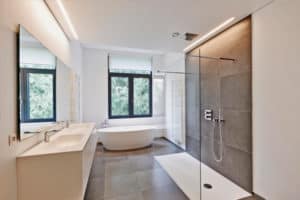
In today’s eco-conscious world, many homeowners are looking for ways to make their renovations more sustainable. Fortunately, there are numerous options to ensure your new bathtub is environmentally friendly.
Eco-Friendly Materials: Opt for bathtubs made from sustainable materials such as bamboo, recycled cast iron, and certain types of acrylic that have been produced with eco-friendly processes. These materials not only reduce environmental impact but also often have a longer lifespan, further minimizing waste.
Water-Saving Features: Modern bathtubs can be equipped with water-saving technologies, such as low-flow faucets and aerators that reduce water usage without compromising on experience. Additionally, some tubs are designed to require less water to fill, thanks to their shape and size, making them a practical choice for eco-conscious homeowners.
Smart Technology: Incorporating smart technologies can enhance your bathing experience while also being kinder to the planet. Features such as digital temperature controls, timers, and even apps that track water usage can help optimize resource use and reduce waste. Some advanced systems recycle water within the tub, providing a luxurious soak with minimal environmental impact.
Once you’ve determined both your bathtub’s style and materials, you’ll need to begin the installation process. We understand that installing a bathtub is hard, but we’ll go over what to expect throughout this process.
—
The Installation Process: What to Expect
The installation process for a new bathtub can be intricate and may require professional assistance to ensure everything goes smoothly. Here’s a step-by-step guide to what you can expect:
Preparation: Before installation begins, ensure your bathroom is ready. This means removing any old fixtures and checking that all plumbing is up to code. It’s also a good idea to prepare a nearby space to store the new tub until it’s time for installation.
Plumbing Adjustments: Often, the existing plumbing needs adjustments to fit the new bathtub. This might include altering the position of the drain, updating water lines, or even installing new outlets for any smart features your bath might have.
Installation of the Tub: Depending on the type of tub, the installation process will vary. Freestanding tubs, for example, typically require less built-in support but may need additional bracing on the floor due to their weight. In contrast, alcove and built-in tubs will need proper framing and securing to the walls and floor.
Sealing and Fitting: Once the tub is in place, it must be sealed to prevent leaks. This involves ensuring that all connections are secure and caulking around the edges where the tub meets the wall or floor.
Testing: After installation, conduct a thorough test to check for leaks and ensure all features are working correctly. Fill the tub, check temperature controls, and ensure all plumbing is functioning smoothly.
Finishing Touches: Finally, complete the renovation with any additional features or decor. This could include installing new fixtures, retiling, or adding aesthetic elements like bath trays or shelving.
You now have a strong understanding of how to pick the best bathtub for your bathroom and what to expect for your installation process. Next, you’ll need to begin your installation process! We’ll recap our main points to ensure this process goes smoothly.
—
Conclusion: Is a Bathtub the Right Choice for You?
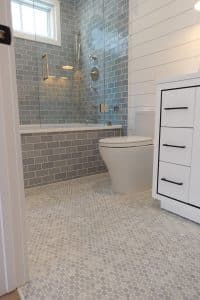
Adding a bathtub to your master bathroom is a substantial but rewarding investment. From aesthetic enhancements to practical benefits, the transformation will profoundly impact your day-to-day living and overall home value.
Recap the Multitude of Benefits:
- Aesthetic Appeal: A bathtub can serve as a striking centerpiece, significantly enhancing the overall design and feel of your bathroom.
- Practical Benefits: Beyond beauty, bathtubs offer practical uses, from relaxation to efficient family bathing solutions.
- Increasing Home Value: A well-designed bathtub can elevate your home’s market value, providing a great return on investment.
- Space Optimization: Careful planning ensures your bathroom layout can accommodate a tub without sacrificing functionality.
- Diverse Options: The wide variety of tub types and materials allows for a tailored approach to your specific needs and design preferences.
- Eco-Friendly Choices: Modern bathtubs offer numerous eco-friendly and smart features that align with contemporary values.
Considering these factors will help you make an informed decision about upgrading your bathroom. Whether you’re looking to boost your home’s value, create a personal oasis, or simply enhance your day-to-day experience, a new bathtub can be a fantastic addition.
For homeowners in Milford, NJ, who are considering this upgrade, the key is in planning and choosing the right professionals to execute your vision. With thoughtful consideration of space, style, materials, and environmental impact, you can transform your master bathroom into a sanctuary of luxury and comfort.
If you have any questions or run into any issues, feel free to contact us Kasco Tile! Trust in the expertise of our professional installers to ensure a smooth and successful renovation. Here’s to creating your perfect bathing space—one that brings relaxation, joy, and increased value to your home.
—
By following this guide, you can embark on your bathtub installation journey with confidence, knowing every aspect is covered to help you achieve the bathroom of your dreams. Now, it’s time to take that first step and bring your vision to life!
